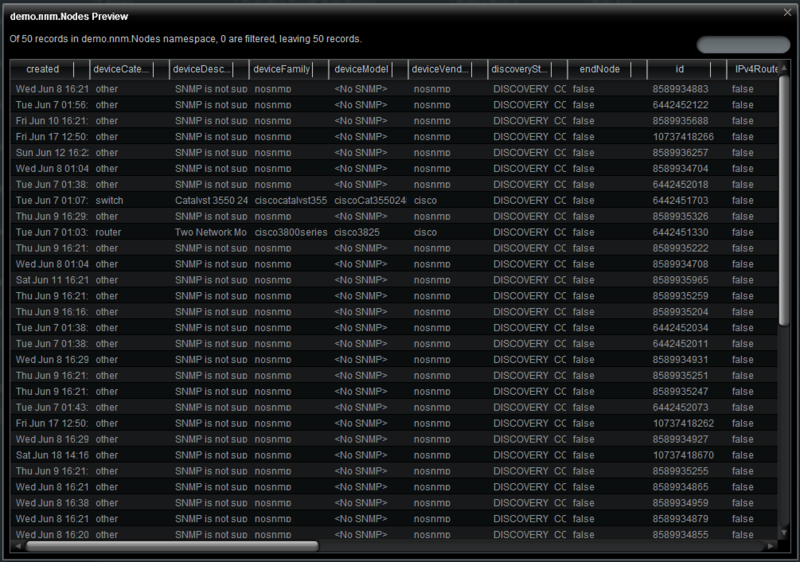Appboard/2.4/builder/data sources/third party/hp nnmi: Difference between revisions
imported>Jason.nicholls (Created page with '{{DISPLAYTITLE:HP NNMi}} The HP NNMi adapter retrieves information about nodes and incidents from the HP Network Node Manager (NNMi) application. ===Connecting with HP NNMi==…') |
imported>David.moore |
||
| (9 intermediate revisions by 2 users not shown) | |||
| Line 1: | Line 1: | ||
{{DISPLAYTITLE:HP NNMi}} | {{DISPLAYTITLE:HP NNMi}} | ||
[[Category:AppBoard 2.4]] | |||
The HP NNMi adapter retrieves information about nodes and incidents from the HP Network Node Manager (NNMi) application. | The HP NNMi adapter retrieves information about nodes and incidents from the HP Network Node Manager (NNMi) application. | ||
== | == Data Source Configuration == | ||
=== Configure Connection Settings === | |||
The table below details the settings you can configure for a <b>HP NNMi</b> Data Source: | |||
{|class="wikitable" | |||
{| | |||
!Name | !Name | ||
!Description | !Description | ||
|- | |||
|'''cacheTimeout''' | |||
|How long the cache manager will keep a response before re-querying the data source. | |||
|- | |- | ||
|'''url''' | |'''url''' | ||
|The | | The base URL of NNM, which should be in the form of "<protocol>://<host>[:port]/" (http://nnm.test.com:8080/ in this example). The base URL can be tested by entering it in a browser and appending "/IncidentBeanService/IncidentBean?wsdl", which should return an XML file describing the Incident web service. | ||
|- | |- | ||
|'''httpAuthUsername''' | |'''httpAuthUsername''' | ||
| | |User name credential used to connect to HP NNMi. | ||
|- | |- | ||
|'''httpAuthPassword''' | |'''httpAuthPassword''' | ||
| | |User password credential used to connect to HP NNMi. | ||
|} | |||
=== Entities === | |||
A successful connection will result in the creation of two data source entities: ''Nodes'' and ''Incidents''. | |||
{|class='wikitable' | |||
!Entity | |||
!Description | |||
|- | |- | ||
|''' | |'''Nodes''' | ||
| | |The Nodes entity contains a list of nodes from NNM. This is consistent with the nodes from the Inventory Workspace of the NNM web interface. | ||
|- | |- | ||
|'''Incidents''' | |||
|The Incidents entity contains all incidents from NNM. This is consistent with All Incidents from the Incident Browsing Workspace of the NNM web interface. | |||
|} | |} | ||
[[File:HP-NNM-NodesPreview.png|thumb|750px|Example data preview of ''Nodes'']] | |||
Latest revision as of 16:41, 3 January 2014
The HP NNMi adapter retrieves information about nodes and incidents from the HP Network Node Manager (NNMi) application.
Data Source Configuration
Configure Connection Settings
The table below details the settings you can configure for a HP NNMi Data Source:
| Name | Description |
|---|---|
| cacheTimeout | How long the cache manager will keep a response before re-querying the data source. |
| url | The base URL of NNM, which should be in the form of "<protocol>://<host>[:port]/" (http://nnm.test.com:8080/ in this example). The base URL can be tested by entering it in a browser and appending "/IncidentBeanService/IncidentBean?wsdl", which should return an XML file describing the Incident web service. |
| httpAuthUsername | User name credential used to connect to HP NNMi. |
| httpAuthPassword | User password credential used to connect to HP NNMi. |
Entities
A successful connection will result in the creation of two data source entities: Nodes and Incidents.
| Entity | Description |
|---|---|
| Nodes | The Nodes entity contains a list of nodes from NNM. This is consistent with the nodes from the Inventory Workspace of the NNM web interface. |
| Incidents | The Incidents entity contains all incidents from NNM. This is consistent with All Incidents from the Incident Browsing Workspace of the NNM web interface. |

